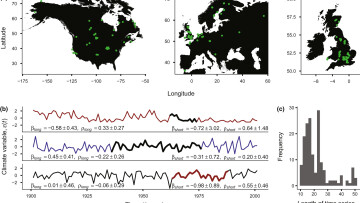The colour of environmental fluctuations associated with terrestrial animal population dynamics

Article was published in Global ecology and biogeography ,Volume28, Issue2, January 2019, Pages 118-130, and can be found in fulltext here >> https://onlinelibrary.wiley.com/doi/full/10.1111/geb.12824
Abstract
Aim
The temporal structure (colour) of environmental variation influences population fluctuations, extinction risk and community stability. However, it is unclear whether environmental covariates linked to population fluctuations are distinguishable from a purely random process (white noise). We aimed to estimate colour coefficients and relative support for three models commonly representing coloured stochastic processes, in environmental series linked to terrestrial animal population fluctuations.
Location
North America and Eurasia.
Time period
1901–2002.
Major taxa studied
Birds, insects and mammals.
Methods
We analysed multiple abiotic environmental covariates, comparing point estimates and confidence intervals of temporal structure in competing models fitted using white noise, autoregressive [AR(1)] and 1/f processes in the time domain and the frequency domain (where time series were analysed after decomposition into different sinusoidal frequencies and their relative powers). All animal time series were sampled annually for ≤ 50 years, potentially inflating type II errors. We also considered 101‐year series of matched environmental covariates, performing a statistical power analysis evaluating our ability to draw robust conclusions.
Results
Temperature‐related variables were associated with the largest fraction of population fluctuations. Ninety‐three per cent of shorter environmental series were indistinguishable from white noise, limited by time‐series length and associated with wide confidence intervals. The longer environmental series analysed in the time domain offered sufficiently high statistical power to identify correctly colour estimates ≥ |0.27|, indicating that 20% of series were best described by a slightly reddened noise process.
Main conclusions
Focusing on the short time‐scales typically available for ecologists, most environmental variables associated with terrestrial animal population fluctuations are best characterized by white noise processes, although type II errors are common. The correct detection of intermediately coloured noise with power 0.8 requires ≥ 16 data points in the time domain or ≥ 47 points in the frequency domain. Over longer time‐scales, where type II errors are less likely, one‐fifth of populations are associated with coloured (often reddened) variables.
Picture: Fig 1
Characteristics of the environmental time series used in the study. (a) The geographical positions in U.S.A. and Canada (left), Eurasia (middle) and U.K. and Ireland (zoomed in, right) of the Global Population Dynamics Database (GPDD) natural population time‐series data, whose fluctuations are associated with the geo‐spatially linked environmental covariates analysed here (a small jitter is added to allow overlapping locations to be shown). (b) Three example environmental time series, coloured based on their associated colour parameters, estimated from the frequency domain (spectral exponent, β; autocorrelation coefficient, ρf (± 95% CIs); middle long series is defined as ‘blue’ based on β alone; black series denote white noise). Upper, middle and lower environmental series show summer frost day frequency, summer precipitation and winter minimum temperature, associated with population dynamics of Euphydryas editha (bay checkerspot butterfly), Contopus virens (eastern wood‐pewee) and Libellula quadrimaculata (four‐spotted chaser), respectively (thick part of lines shows dates corresponding to available animal population data). (c) Length (in years) of the short time series used in the analyses; median = 18 years